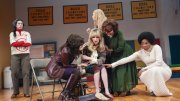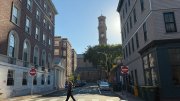The class of 1910 dropout who designed the SS United States—the fastest, safest, most beautiful transatlantic liner ever built—had the diction of a Philadelphia aristocrat, the mind of an artist, and the mouth of a sailor (a trait picked up from years of working in shipyards).
William Francis Gibbs’s love affair with ships began when the eight-year-old and his father watched the ocean liner St. Louis roar down the ways at Philadelphia’s Cramp Shipyard. “[F]rom that day forward I dedicated my life to ships,” Gibbs recalled. But when he arrived in Cambridge in the fall of 1906, he had no apparent knack for engineering or leadership. Shy, sickly, and terrified of simple addition, he got into Harvard’s Lawrence Scientific School at 20, despite abysmal grades, most likely because of his family’s wealth. His self-made father, who earned millions manufacturing gas equipment with Peter Widener (grandfather of Harry, A.B. 1907), was not happy when his son chose to study engineering. “Most of the engineers he knew,” Gibbs said, “were pretty impractical people.”
The introverted Gibbs was not popular—his rambunctious peers often “filled him with alarm.” He was a prep-school-educated Protestant living in a “Gold Coast” dormitory, but no final club wanted him. Alone in his Claverly suite, he studied blueprints of the newest British naval vessels late into the night. Yet he carefully locked his desk when he left his room, fearing ridicule as “the eeriest of all the eccentrics in three centuries of Harvard life if it were known that he was busy improving British battleships.”
Meanwhile, he proved a bad engineering student, and withdrew from Harvard early in his sophomore year. After a round trip to Europe with his younger brother aboard Cunard’s new liners Lusitania and Mauretania, he returned to Cambridge the following fall, switched to economics in the College, and excelled. Yet he did not graduate: his father went bankrupt, and Gibbs left school.
Eventually he enrolled at Columbia and worked his way through college and law school there. Yet he kept his passion for ship design. “I studied engineering at night out of books,” he recalled. “That’s the way to really learn things—by yourself.” In 1915, the unhappy lawyer finagled his way into an apprenticeship with the nation’s leading naval architect, Admiral David W. Taylor, who led the U.S. Navy’s expansion under Theodore Roosevelt, A.B. 1880.
Gibbs never looked back, steadily building up his own naval engineering firm and hiring talented subordinates. (“Take it away,” he was known to snarl when shown what he deemed inferior workmanship. “Bring me the best.”) He married the cultured Vera Cravath, whose father was one of the most powerful lawyers in New York. In the 1930s, encouraged by ship enthusiast Franklin Roosevelt, A.B. ’04, Gibbs designed the revolutionary Mahan-class destroyers, the first combat vessels to use high-pressure, high-temperature steam turbines. Their speed and maneuverability probably helped win the war in the Pacific. During World War II, Gibbs & Cox designed 70 percent of all navy ships, including the Normandy landing craft, and devised a means to mass-produce Liberty Ship cargo vessels faster than the enemy could sink them.
Gibbs came back to Harvard in 1946, accepting an honorary Phi Beta Kappa key for his war work. That same year, he started sketching plans for the American superliner he had dreamed of creating since his days in Cambridge. Completed in 1952, the SS United States was nearly three football fields long and 12 stories high from keel to funnel top. His “ideal ship” conveyed speed and power even at rest: a jet-black hull; knife-like prow; two finned, red, white, and blue funnels. She could carry 2,000 passengers in her sleek, modern, comfortable, and fireproof interiors. (Boasting a navy-grade hull, extra compartmentalization, and a lightweight aluminum superstructure, the United States was the anti-Titanic.) But in the event of war, she could quickly be transformed into a troopship for 14,000 soldiers—the reason why the Cold War military paid two-thirds of her $78-million cost. Her major design features and top speed (45 land miles per hour) were classified, but on her maiden voyage, in July 1952, she captured the commercial record between New York and Southampton, making the trip in three days, 10 hours, and 40 minutes at an average speed of 35.59 knots and slashing 10 hours off her rival Queen Mary’s best time.
For the next 15 years, Gibbs met the ship each time she arrived in New York. “You can’t set her on fire, you can’t sink her, and you can’t catch her,” he declared. (“Is it possible for a mature man, a member of the University, Century,…and New York Yacht Clubs, to fall in love with a ship?” asked The New Yorker.) She was the ship of choice for presidents, royalty, movie stars, and thousands of immigrants.
The day after Gibbs died in 1967, the United States whistled a melancholy salute as she passed his Lower Manhattan office. She sailed for another two years before being taken out of service, her speed and potential wartime use made irrelevant by jet aircraft. Since then, America’s greatest liner has been sold many times and stripped of her fittings, yet she miraculously endures, rusting at a pier in Philadelphia, where her latest owners, the SS United States Conservancy, hope to restore her as a waterfront attraction for all Americans to enjoy.
Steven B. Ujifusa ’01 is the author the newly published A Man and His Ship: America’s Greatest Naval Architect and His Quest to Build the SS United States, a biography of William Francis Gibbs (Simon & Schuster). He also serves on the advisory council of the SS United States Conservancy.










